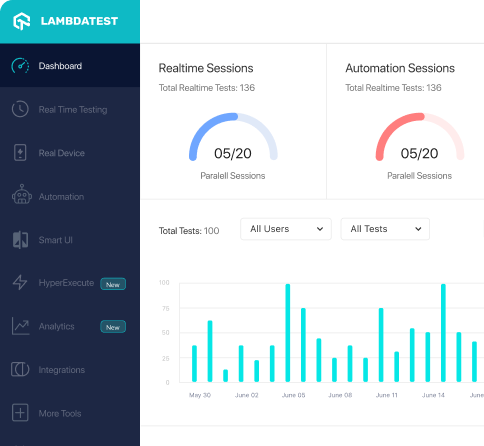How to use IterableAssert_containsSubsequence_Test class of org.assertj.core.api.iterable package
Best Assertj code snippet using org.assertj.core.api.iterable.IterableAssert_containsSubsequence_Test
...24 * Tests for <code>{@link AbstractIterableAssert#containsSubsequence(Object[])}</code>.25 *26 * @author Harry Cummings27 */28public class IterableAssert_containsSubsequence_Test extends IterableAssertBaseTest {2930 @Override31 protected ConcreteIterableAssert<Object> invoke_api_method() {32 return assertions.containsSubsequence("Luke", "Leia");33 }3435 @Override36 protected void verify_internal_effects() {37 verify(iterables).assertContainsSubsequence(getInfo(assertions), getActual(assertions), array("Luke", "Leia"));38 }39}
...IterableAssert_containsSubsequence_Test
Using AI Code Generation
1package org.assertj.core.api.iterable;2import static org.assertj.core.api.Assertions.assertThat;3import java.util.Arrays;4import java.util.List;5import org.junit.jupiter.api.Test;6class IterableAssert_containsSubsequence_Test {7 void should_pass_if_actual_contains_subsequence() {8 List<String> actual = Arrays.asList("Yoda", "Luke", "Leia", "Obiwan");9 assertThat(actual).containsSubsequence("Luke", "Leia");10 assertThat(actual).containsSubsequence("Luke", "Obiwan");11 assertThat(actual).containsSubsequence("Luke", "Leia", "Obiwan");12 }13 void should_pass_if_actual_and_subsequence_are_equal() {14 List<String> actual = Arrays.asList("Yoda", "Luke", "Leia", "Obiwan");15 assertThat(actual).containsSubsequence("Yoda", "Luke", "Leia", "Obiwan");16 }17 void should_fail_if_actual_does_not_contain_subsequence() {18 List<String> actual = Arrays.asList("Yoda", "Luke", "Leia", "Obiwan");19 AssertionError assertionError = expectAssertionError(() -> assertThat(actual).containsSubsequence("Luke", "Vador"));20 assertThat(assertionError).hasMessageContainingAll("Expecting:", "to contain subsequence:", "but could not find the following elements:", "[\"Vador\"]");21 }22 void should_fail_if_actual_is_empty_whatever_subsequence_is() {23 List<String> actual = Arrays.asList();24 AssertionError assertionError = expectAssertionError(() -> assertThat(actual).containsSubsequence("Luke", "Vador"));25 assertThat(assertionError).hasMessageContainingAll("Expecting:", "to contain subsequence:", "but could not find the following elements:", "[\"Luke\", \"Vador\"]");26 }27 void should_fail_if_subsequence_is_empty() {28 List<String> actual = Arrays.asList("Yoda", "Luke", "Leia", "Obiwan");29 AssertionError assertionError = expectAssertionError(() -> assertThat(actual).containsSubsequence());30 assertThat(assertionError).hasMessageContainingAll("ExpectingIterableAssert_containsSubsequence_Test
Using AI Code Generation
1package org.assertj.core.api.iterable;2import org.assertj.core.api.*;3import org.assertj.core.internal.*;4import org.assertj.core.util.*;5import org.junit.*;6import static org.assertj.core.api.Assertions.*;7import static org.assertj.core.test.ExpectedException.none;8import static org.assertj.core.util.Arrays.array;9import static org.assertj.core.util.FailureMessages.*;10import static org.assertj.core.util.Lists.*;11import static org.assertj.core.util.Sets.*;12import static org.mockito.Mockito.*;13import java.util.*;14public class IterableAssert_containsSubsequence_Test {15 public ExpectedException thrown = none();16 private Failures failures;17 private List<String> actual;18 private List<String> subsequence;19 public void setUp() {20 failures = spy(new Failures());21 actual = newArrayList("Luke", "Yoda", "Leia");22 subsequence = newArrayList("Yoda", "Leia");23 }24 public void should_pass_if_actual_contains_subsequence() {25 new IterableAssert(actual).usingElementComparator(CaseInsensitiveStringComparator.instance).containsSubsequence(subsequence);26 }27 public void should_pass_if_actual_and_subsequence_are_equal() {28 new IterableAssert(actual).usingElementComparator(CaseInsensitiveStringComparator.instance).containsSubsequence(actual);29 }30 public void should_fail_if_actual_does_not_contain_subsequence() {31 thrown.expect(AssertionError.class, shouldContainSubsequence(actual, subsequence).create());32 new IterableAssert(actual).usingElementComparator(CaseInsensitiveStringComparator.instance).containsSubsequence(subsequence);33 }34 public void should_fail_if_actual_is_empty() {35 thrown.expect(AssertionError.class, shouldContainSubsequence(emptyList(), subsequence).create());36 new IterableAssert(emptyList()).usingElementComparator(CaseInsensitiveStringComparator.instance).containsSubsequence(subsequence);37 }38 public void should_fail_if_subsequence_is_empty() {39 thrown.expect(IllegalArgumentException.class, "The given Iterable should not be empty");40 new IterableAssert(actual).usingElementComparator(CaseInsensitiveStringComparator.instance).containsSubsequence(emptyList());41 }42 public void should_fail_if_subsequence_is_null() {43 thrown.expect(IllegalArgumentException.class, "The given Iterable should not be null");IterableAssert_containsSubsequence_Test
Using AI Code Generation
1import org.assertj.core.api.iterable.IterableAssert_containsSubsequence_Test;2import org.junit.Test;3import static org.assertj.core.api.Assertions.assertThat;4public class IterableAssert_containsSubsequence_Test {5 public void test() {6 assertThat(new String[] { "a", "b", "c" }).containsSubsequence("a", "c");7 assertThat(new String[] { "a", "b", "c" }).containsSubsequence("a", "b", "c");8 assertThat(new String[] { "a", "b", "c" }).containsSubsequence("b", "c");9 assertThat(new String[] { "a", "b", "c" }).containsSubsequence("b");10 assertThat(new String[] { "a", "b", "c" }).containsSubsequence("c");11 }12}13 at org.assertj.core.api.iterable.IterableAssert_containsSubsequence_Test.test(IterableAssert_containsSubsequence_Test.java:12)14public void test() {15 assertThat(new String[] { "a", "b", "c" }).containsSubsequence("a", "d");16}Blogs
Check out the latest blogs from LambdaTest on this topic:
Howdy testers! June has ended, and it’s time to give you a refresher on everything that happened at LambdaTest over the last month. We are thrilled to share that we are live with Cypress testing and that our very own LT Browser is free for all LambdaTest users. That’s not all, folks! We have also added a whole new range of browsers, devices & features to make testing more effortless than ever.
In 2007, Steve Jobs launched the first iPhone, which revolutionized the world. But because of that, many businesses dealt with the problem of changing the layout of websites from desktop to mobile by delivering completely different mobile-compatible websites under the subdomain of ‘m’ (e.g., https://m.facebook.com). And we were all trying to figure out how to work in this new world of contending with mobile and desktop screen sizes.
Desired Capabilities is a class used to declare a set of basic requirements such as combinations of browsers, operating systems, browser versions, etc. to perform automated cross browser testing of a web application.
Xamarin is an open-source framework that offers cross-platform application development using the C# programming language. It helps to simplify your overall development and management of cross-platform software applications.
The count of mobile users is on a steep rise. According to the research, by 2025, it is expected to reach 7.49 billion users worldwide. 70% of all US digital media time comes from mobile apps, and to your surprise, the average smartphone owner uses ten apps per day and 30 apps each month.
Automation Testing Tutorials
Learn to execute automation testing from scratch with LambdaTest Learning Hub. Right from setting up the prerequisites to run your first automation test, to following best practices and diving deeper into advanced test scenarios. LambdaTest Learning Hubs compile a list of step-by-step guides to help you be proficient with different test automation frameworks i.e. Selenium, Cypress, TestNG etc.
LambdaTest Learning Hubs:
- JUnit Tutorial
- TestNG Tutorial
- Webdriver Tutorial
- WebDriverIO Tutorial
- Protractor Tutorial
- Selenium 4 Tutorial
- Jenkins Tutorial
- NUnit Tutorial
- Jest Tutorial
- Playwright Tutorial
- Cypress Tutorial
- PyTest Tutorial
YouTube
You could also refer to video tutorials over LambdaTest YouTube channel to get step by step demonstration from industry experts.
Most used methods in IterableAssert_containsSubsequence_Test
Try LambdaTest Now !!
Get 100 minutes of automation test minutes FREE!!



